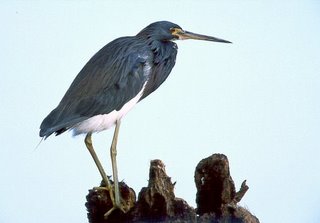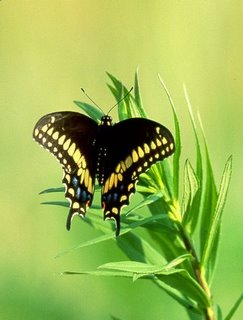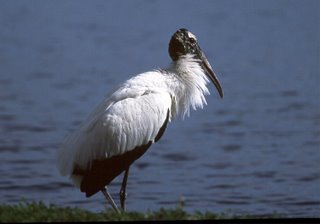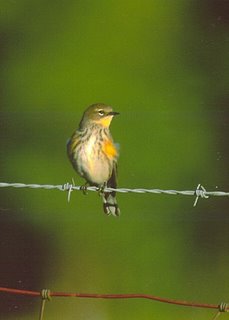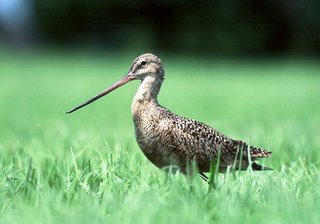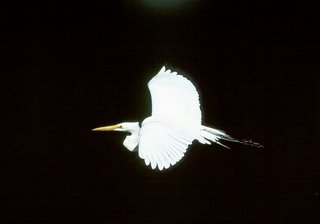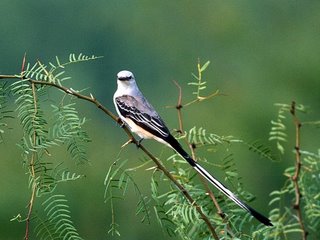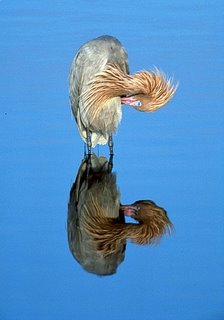One of the first things that attracted me to birding was ducks, wild ducks. Seeing them for the first time through binoculars and then a scope I was amazed at their variation of colors
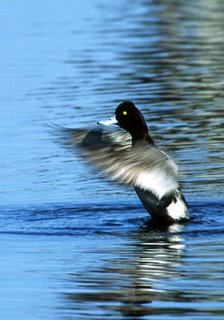
, shapes, and sizes. Part of the challenge of bird photography is getting close enough to get a recognizable image of your subject. Often this is pure luck. Other times you get your desired image due to good planning. In the image at left of a Lesser Scaup it was kind of a combination of the two. I knew Scaup sometimes were present on a small pond in a recreational park in Titusville, Florida. I planned a stop there during a time of day when the lighting was good for photography. The luck was that a Scaup was present and that it was close enough to the shore that I could get a decent closeup image. The additional luck was that he was in a mood to lift himself up out of the water and flap his wings allowing more of an action shot . When the lighting is right the head is a glossy purple . The eyes are bright yellow and the bill is a cool shade of blue. I have always thought "blue-billed duck" would have been a better name. These ducks are often seen in large floating groups called "rafts". The Lesser Scaup has a slightly larger cousin called the Greater Scaup. For many, it is often difficult to tell them apart. There are differences, such as head shape. A study of your field guide will be useful in making the proper ID. I can only wish that all photo subjects would be as cooperative as this Lesser Scaup.
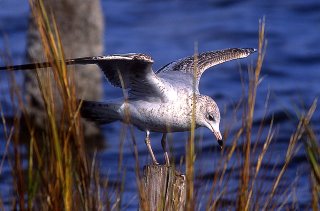
 Even before arriving at your chosen seaside you often see the flying antics of a "Sea Gull" announcing the immediacy of your chosen destination.. However, most people would be hard pressed to identify the species of the Gull announcing the attainment of the sought goal. Within the 50 US states there are some 27 species of gulls. Of course not all species are represented at every seashore. For the East coast the two most prevalent gulls are the Laughing Gull and the Ringbilled Gull which is represented in the photo provided. While most often seen on the coast gulls often move inland during the winter months. You may see them at local lakes or even on large paved parking lots where they gather in large numbers. Who hasn't enjoyed feeding gulls leftover bread pieces by tossing them up in the air on the beach or from the bow of a boat on the open water. Gulls are very adept at making in flight catches. At times I have felt threatened by the mass of gulls that sometimes accumulate during this feeding process. It just wouldn't be the same without gulls at the beach.
Even before arriving at your chosen seaside you often see the flying antics of a "Sea Gull" announcing the immediacy of your chosen destination.. However, most people would be hard pressed to identify the species of the Gull announcing the attainment of the sought goal. Within the 50 US states there are some 27 species of gulls. Of course not all species are represented at every seashore. For the East coast the two most prevalent gulls are the Laughing Gull and the Ringbilled Gull which is represented in the photo provided. While most often seen on the coast gulls often move inland during the winter months. You may see them at local lakes or even on large paved parking lots where they gather in large numbers. Who hasn't enjoyed feeding gulls leftover bread pieces by tossing them up in the air on the beach or from the bow of a boat on the open water. Gulls are very adept at making in flight catches. At times I have felt threatened by the mass of gulls that sometimes accumulate during this feeding process. It just wouldn't be the same without gulls at the beach.
